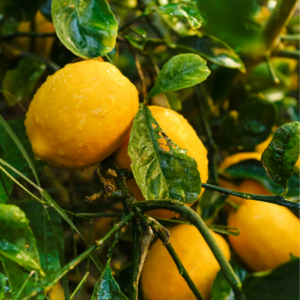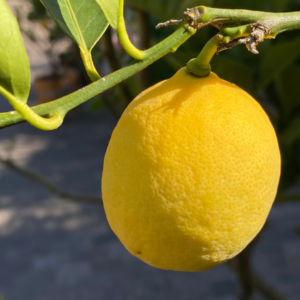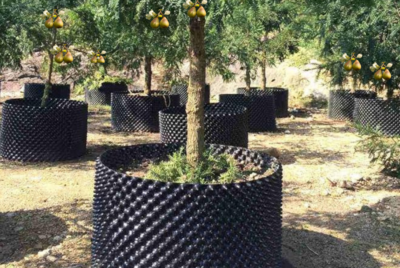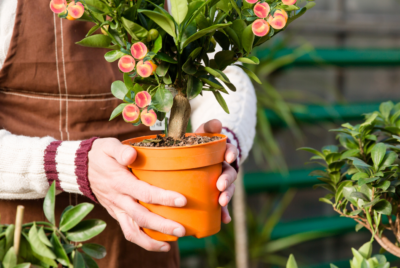Beginner’s Guide To Growing Lemon Trees In Your Backyard
Backyard citrus trees can bring life and vibrancy to your outdoor space, not to mention the delicious fruits they can provide. If you’ve been considering adding a lemon tree to your backyard but don’t know where to start, this guide is here to help. From choosing the right variety of lemon tree to important care tips for healthy growth, we will walk you through the basics of cultivating your own lemon oasis. By following these steps, you can enjoy the fruits of your labor in no time. Let’s get started on this citrus-growing adventure!

Key Takeaways:
- Choose the right location: Lemon trees require full sun and well-drained soil to thrive. Make sure to plant them in a spot that receives at least 6-8 hours of sunlight per day.
- Provide regular watering: Lemon trees need consistent moisture, especially during the growing season. Water them deeply once or twice a week, depending on the weather and soil conditions.
- Fertilize appropriately: Use a balanced fertilizer specifically designed for citrus trees to provide them with imperative nutrients. Apply the fertilizer in early spring and late summer for best results.
- Prune for shape and health: Pruning helps to promote air circulation, reduce disease, and shape the tree for better fruit production. Remove any dead or crossing branches to keep the tree healthy.
- Protect from frost: Lemon trees are sensitive to cold temperatures, so it’s important to protect them during winter. Cover the trees with frost cloth or bring them indoors if temperatures drop below freezing.
Understanding Lemon Trees
Some key information to know about lemon trees includes the different types available, factors to consider before growing them, and imperative care tips to ensure a healthy and fruitful tree in your backyard.
Types of Lemon Trees
Some common types of lemon trees include Eureka, Lisbon, Meyer, Variegated Pink Lemon, and Ponderosa Lemon. Each type has its unique characteristics in terms of fruit size, taste, and growth habits. Knowing the differences between these types can help you choose the best one for your backyard.
| Eureka | Lisbon |
| Meyer | Variegated Pink Lemon |
| Ponderosa Lemon |
Factors to Consider Before Growing Lemon Trees

Any aspiring lemon tree grower should consider factors such as climate, soil type, space availability, watering, and sunlight exposure before planting a lemon tree in their backyard. This information is crucial for the successful growth and fruit production of your lemon tree.
- Climate
- Soil type
- Space availability
- Watering
- Sunlight exposure
For instance, lemon trees thrive in warm climates and require well-draining, slightly acidic soil to grow successfully. Inadequate sunlight exposure can lead to poor fruit development, while overwatering can cause root rot. It is imperative to assess these factors before planting a lemon tree to ensure optimal growth and fruit yield.
Preparing to Plant
Selecting the Right Location
If you’re looking to plant a lemon tree in your backyard, selecting the right location is crucial. Lemon trees thrive in full sunlight, so choose a spot in your yard that receives at least 6-8 hours of sunlight daily. Additionally, ensure that the location has well-draining soil to prevent waterlogging, which can lead to root rot.
Soil Preparation and Requirements
The key to successful lemon tree growth lies in the soil preparation. Lemon trees prefer well-draining soil with a slightly acidic pH between 5.5 and 6.5. Before planting, test the soil pH and make amendments if necessary. Incorporate organic matter like compost or peat moss to improve soil structure and fertility.
The pH level of the soil is crucial to ensure nutrient availability to the lemon tree roots. Avoid planting in clay soils or areas prone to waterlogging, as this can hinder root development and lead to poor growth. When planting, ensure the soil is loose and aerated to encourage healthy root growth.
Planting a lemon tree is a rewarding experience that can provide you with fresh citrus fruits right from your backyard. By selecting the right location with adequate sunlight and well-draining soil, you can set your lemon tree up for success from the start. Remember to regularly monitor soil moisture and provide proper care to ensure your lemon tree thrives and produces an abundance of flavorful fruits.
Planting Your Lemon Tree: A Step-by-Step Guide
| When to Plant Lemon Trees | Tips for Planting and Initial Care |
When to Plant Lemon Trees

While lemon trees can be planted indoors in containers at any time of the year, it is best to plant them outdoors in the spring after the last frost has passed. This timing allows the tree to establish its roots before the harsh conditions of winter.
Tips for Planting and Initial Care
Now, when planting your lemon tree, ensure it is placed in well-draining soil with plenty of sunlight. Water the tree regularly, especially during the growing season, but be cautious not to overwater. After planting, consider mulching around the base of the tree to retain moisture and suppress weeds.
- Well-draining soil
- Plenty of sunlight
- Regular watering
Lemon trees are vulnerable to frost, so protection should be provided in colder climates. Keep an eye out for pests such as aphids and scale insects that can harm the tree. After the first year, consider fertilizing with a citrus-specific fertilizer to promote healthy growth.
Maintenance and Care for Your Lemon Tree
Watering and Feeding Your Lemon Tree
Despite being drought-tolerant, lemon trees require consistent watering, especially during dry spells. Overwatering can lead to root rot, while underwatering can result in poor fruit quality. To ensure the optimal growth of your lemon tree, water it deeply but infrequently, allowing the top few inches of soil to dry out between waterings. Additionally, feeding your lemon tree with a balanced fertilizer high in nitrogen will promote healthy foliage and fruit development.
Pruning and Protecting Your Lemon Tree
The pruning and protection of your lemon tree are vital for its overall health and productivity. Regular pruning helps to shape the tree, improve air circulation, and remove dead or diseased branches. Furthermore, protecting your lemon tree from pests and diseases is crucial. Using natural insecticides and fungicides can help prevent infestations and keep your tree thriving.
With proper care and attention, your lemon tree can provide you with an abundance of delicious fruit for years to come.
Harvesting and Enjoying Your Lemons

Signs Your Lemons Are Ready to Harvest
To ensure that you pick your lemons at the peak of flavor, it’s important to look for a few key signs. Color is a major indicator – ripe lemons will have a vibrant yellow hue. Check the firmness of the fruit as well – a slight give when gently squeezed means they are ripe. Smell the lemons – a fragrant citrus scent indicates maturity. Once you notice these signs, harvest your lemons carefully to avoid damaging the tree.
Uses for Your Homegrown Lemons
Any lemon enthusiast will tell you that the uses for homegrown lemons are endless. From creating refreshing lemonade to adding a zesty kick to your dishes, lemons are versatile and vital in the kitchen. Use the juice to elevate your marinades, salad dressings, or even bake tangy lemon bars. You can also use the zest to enhance the flavor of desserts or savory dishes. Don’t forget the health benefits – lemons are high in vitamin C and antioxidants, making them a great addition to your diet.
The Pros and Cons of Growing Lemon Trees
Once again, it’s important to weigh the pros and cons before deciding to grow lemon trees in your backyard. Here is a breakdown of the advantages and challenges you may face:
| Advantages | Challenges |
| Fresh, organic lemons at your fingertips | Prone to pests and diseases |
| Cost-effective compared to store-bought lemons | Requires regular pruning and maintenance |
| Enhances the aesthetic appeal of your backyard | Takes several years to mature and bear fruit |
| Opportunity to enjoy the satisfaction of growing your own fruit | Susceptible to weather conditions |
Advantages of Growing Your Own Lemons
Now, cultivating your own lemon trees comes with several advantages. You can enjoy a constant supply of fresh, organic lemons right in your backyard. This not only saves you money but also ensures that you have access to high-quality produce whenever you need it.
Challenges and How to Overcome Them

Lemon trees come with their own set of challenges. They are prone to pests and diseases, which can affect their growth and fruit production. To overcome this, it is important to regularly inspect your trees for any signs of infestation and take preventative measures such as using organic pesticides.
Conclusion
Conclusively, growing lemon trees in your backyard can be a rewarding experience with the right knowledge and care. From selecting the right variety to providing optimal growing conditions, this beginner’s guide has equipped you with the basics to successfully cultivate healthy lemon trees. To further enhance your skills in gardening, explore the comprehensive resources available in the Gardening for Beginners: Learn how to properly care for your blog post. With dedication and proper care, your backyard can soon be flourishing with vibrant lemon trees!
FAQ
Q: Why should I consider growing a lemon tree in my backyard?
A: Lemon trees are not only beautiful additions to your backyard, but they also provide fresh, organic lemons for cooking, cleaning, and even for health purposes.
Q: What is the best time to plant a lemon tree?
A: The best time to plant a lemon tree is in the spring after the last frost has passed. This will give the tree time to establish its roots before the hot summer months.
Q: How much sunlight does a lemon tree need?
A: Lemon trees thrive in full sunlight, so it’s best to place them in a location where they can receive at least 6-8 hours of direct sunlight per day.
Q: How often should I water my lemon tree?

A: Lemon trees prefer consistently moist soil, so it’s important to water them regularly, especially during hot summer months. However, be careful not to overwater, as this can lead to root rot.
Q: How do I protect my lemon tree from pests and diseases?
A: To protect your lemon tree from pests and diseases, regularly inspect the leaves and fruits for any signs of infestation. You can also use organic insecticidal soap or neem oil to control common pests like aphids and spider mites.
Companion Planting For Echinasea
Brussell Sprouts COmpanion Planting
Companion Planting Coral Bells
How to Grow Trees 5 times Faster




